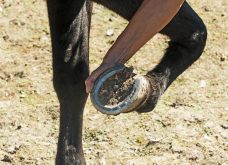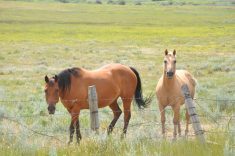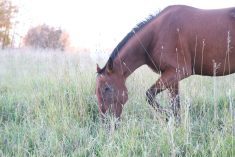Monensin, also known under its trade name, Rumensin, is extremely toxic to horses. It is one of the most common accidental poisonings in horses, and yet often goes unrecognized.
Farm animals such as horses, cows, chickens and pigs can and commonly do share similar feeds. However, it is extremely important that horse owners are aware that feeds intended for promoting growth in cattle, chickens and swine may contain ingredients fatal to horses. Many modern livestock feedstuffs contain ionophores, feed additives used to enhance feed efficiency, promote growth and control coccidiosis, a protozoan parasite, in cattle, swine and poultry.
Read Also

Pig transport stress costs pork sector
Popular livestock trailer designs also increase pig stress during transportation, hitting at meat quality, animal welfare and farm profit, Agriculture and Agri-Food Canada researcher says
Monensin is the most familiar ionophore. Others include lasalocid (Bovatec), an anti-bloat agent; salinomycin, narasin, maduramicin, laidlomycin and semduramicin. The concentrated product is rarely found on the farm. It is more commonly available as a premix or in pelleted feeds. Ionophores can also be found in molasses-based mineral blocks for ruminants.
Horses are much more sensitive to ionophore toxicity than other species, yet the exact reason is not well understood. Any exposure to monensin is cause for concern, as horses are nearly 20 times more sensitive than cattle and 200 times more susceptible than poultry on an mg-per-kg body weight basis. A common case of this poisoning is seen in horses used to work feedlots, who have been poisoned by consuming cattle feed containing monensin.
Ionophores disrupt the normal flux of ions, particularly sodium and potassium, across the cell membrane. This leads to failure of the mitochondria, which is the part of the cell responsible for energy production. Therefore, the highly energetic tissues of the body such as the heart and skeletal muscles are primarily affected with intoxication. Ingestion of sublethal doses results in structural damage to the heart as damaged heart muscles are replaced by fibrous tissue during the healing process. More severe intoxication ultimately leads to death of the heart muscles.
Symptoms
Clinical symptoms following ingestion of monensin are dose dependent and individual horse dependent. Affected horses may just look like a severe colic with their heart rate consistently double or triple normal rhythm and breathing laboured. Symptoms are progressive and include reluctance to eat, abdominal pain, sweating, excessive urination and an unsteadiness of foot.
Following the initial episode of illness, horses have a guarded prognosis, often exhibiting signs of congestive heart failure. Sudden deaths are common weeks to months following exposure. Symptoms of monensin intoxication are often non-specific, making it difficult for veterinarians and horse owners to confirm the problem.
Once exposure has been discovered, veterinarians will initiate symptomatic and supportive care. Products such as activated charcoal or clays may be used to block further absorption, however, there is no antidote for the monensin poisoning that already occurred. Some horses might die regardless of treatment, others might recover over days, weeks or months. Of those that survive, some develop irreparable heart damage and so never fully recover.
Knowing the devastating effects ionophores can have on your horse makes it obvious that prevention is of key importance. Accidental ingestion of ill-fated feeds must be avoided.



















